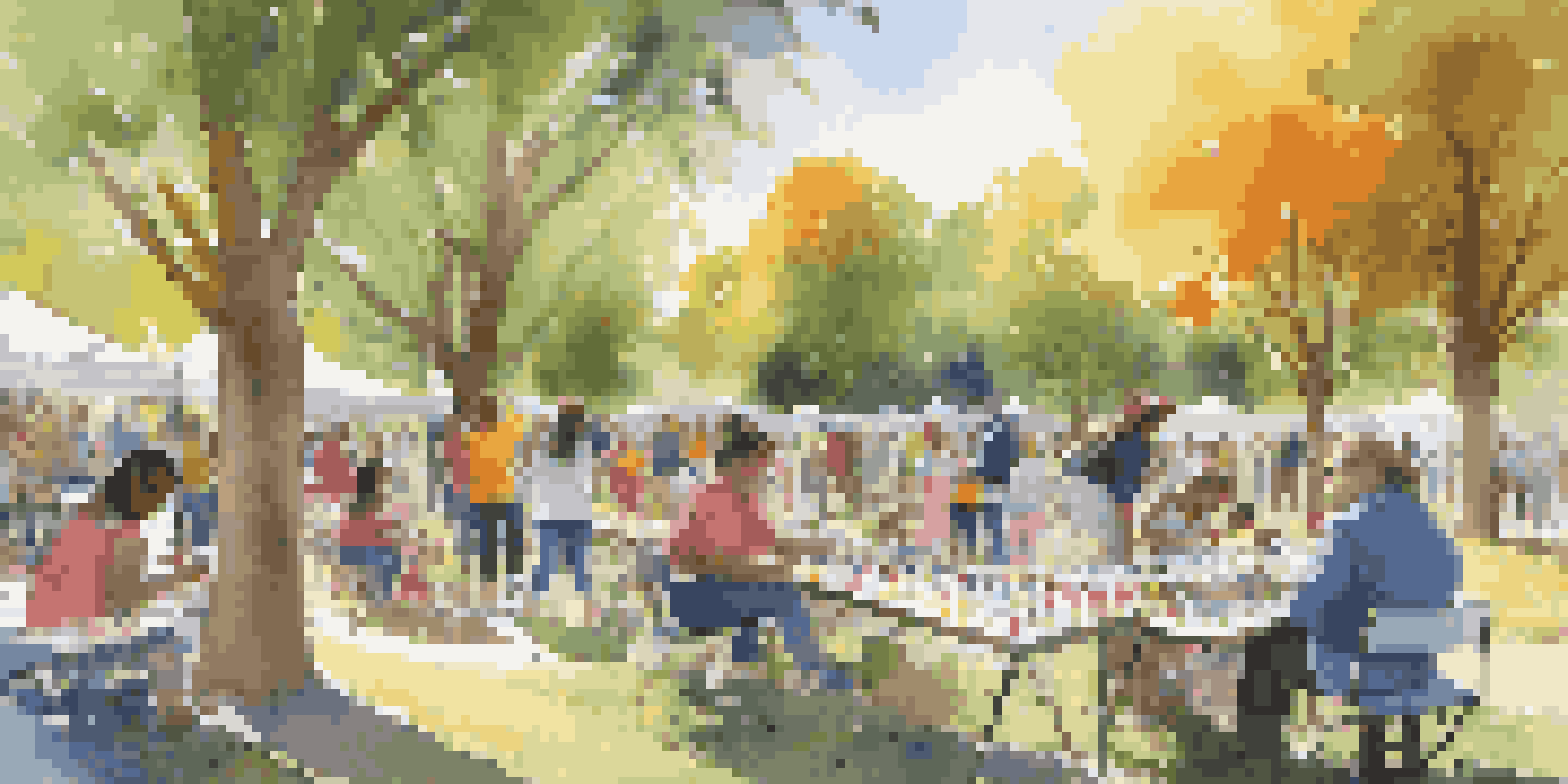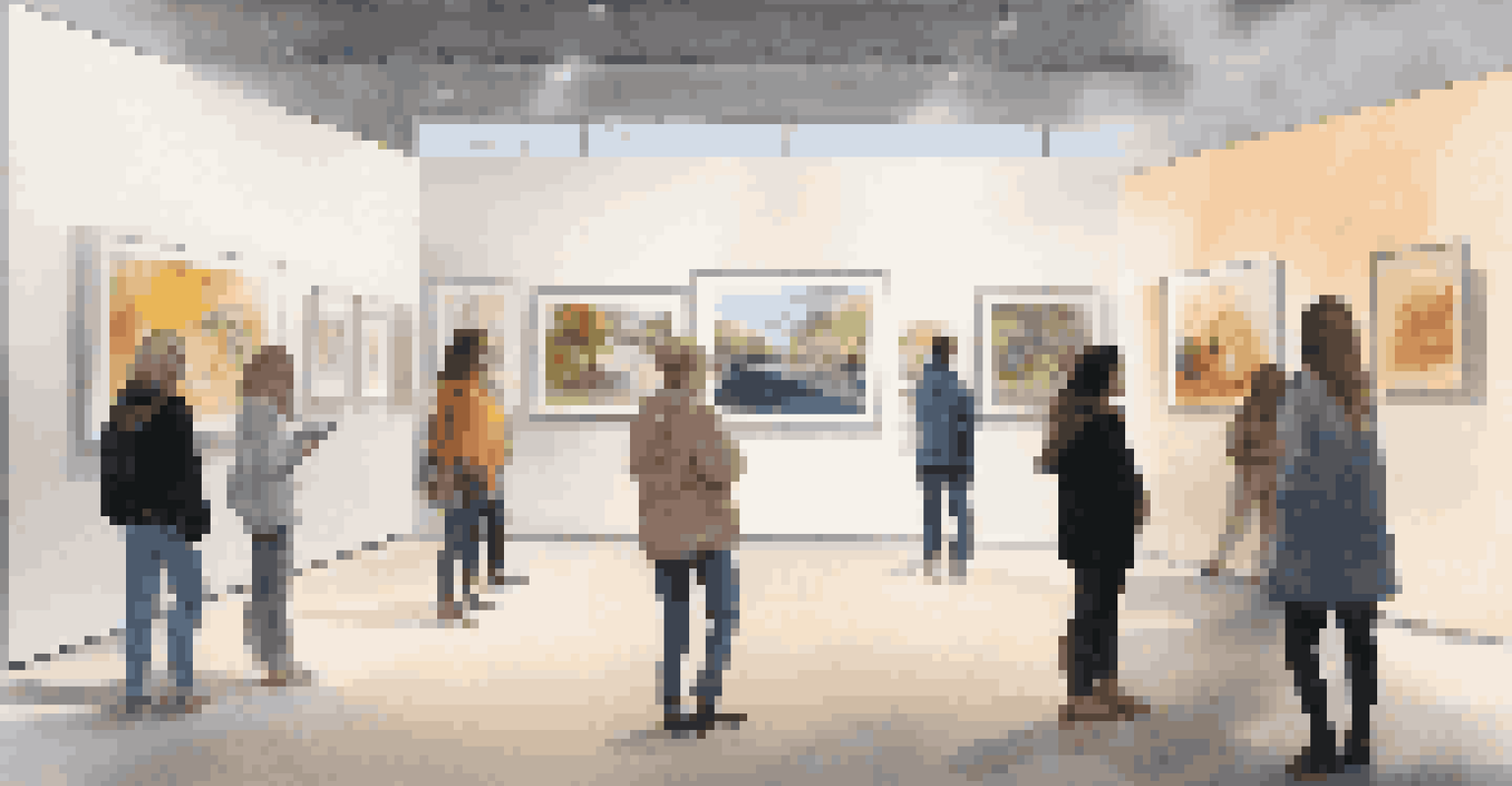Art Collectives: Strengthening Community Ties and Collaboration

What Are Art Collectives and Their Purpose?
Art collectives are groups of artists who come together to create, share, and promote art collaboratively. Unlike traditional galleries, these collectives often emphasize community engagement and collective decision-making. This means that each artist's voice is valued, creating a rich tapestry of creativity and innovation.
Art is not a solitary endeavor; it’s a shared experience that reflects the voices of the community.
The primary purpose of art collectives is to provide a platform for artists to showcase their work while fostering a sense of belonging. By working together, artists can pool resources, share skills, and support each other's growth. This collaborative spirit not only enhances individual projects but also strengthens the collective as a whole.
Moreover, art collectives often engage with their local communities, hosting events and exhibitions that invite public participation. This connection between artists and the community fosters deeper relationships and encourages dialogue about art, culture, and social issues.
The Benefits of Collaboration in Art Collectives
Collaboration in art collectives brings numerous benefits, including the exchange of ideas and diverse perspectives. When artists collaborate, they can challenge each other's thinking and push creative boundaries. This collaborative environment fosters innovation, resulting in unique and thought-provoking artworks.

Additionally, working within a collective can alleviate the financial burdens often faced by individual artists. By sharing studio space, equipment, and marketing efforts, artists can reduce costs significantly. This cooperative approach not only makes art more accessible but also encourages artists to take risks in their work.
Art Collectives Foster Collaboration
Art collectives encourage artists to collaborate, sharing resources and ideas that lead to innovative and thought-provoking artworks.
Lastly, collaboration helps build a strong support network among artists, which is invaluable in the often isolating world of art. This sense of camaraderie can lead to lasting friendships, mentorships, and a shared enthusiasm for artistic growth.
Art Collectives and Community Engagement
Art collectives play a crucial role in engaging local communities, often organizing workshops, exhibitions, and public art projects. These initiatives invite community members to participate in the creative process, breaking down barriers between artists and the public. As a result, art becomes a shared experience rather than an exclusive endeavor.
The best way to predict the future is to create it together.
By involving community members, art collectives can reflect the diverse voices and stories within their neighborhoods. This inclusivity not only enriches the artwork produced but also fosters a sense of pride and ownership among local residents. When people see their experiences represented in art, it creates a deeper connection to the collective and its mission.
Furthermore, these engagements can spark conversations about important social issues, encouraging dialogue and understanding. Art collectives often use their platform to raise awareness about topics such as environmental sustainability, social justice, and cultural heritage, making art a vehicle for change.
The Role of Technology in Art Collectives
In today’s digital age, technology plays a vital role in the operations and outreach of art collectives. Social media platforms allow collectives to showcase their work, connect with a broader audience, and engage with art enthusiasts globally. This online presence can lead to increased visibility and opportunities for collaboration.
Additionally, technology facilitates the creation of virtual exhibitions and online workshops, making art accessible to those who may not be able to attend in-person events. This adaptability has become especially important in recent years, as many collectives have pivoted to virtual platforms to continue their work amidst challenges.
Community Engagement is Essential
By actively involving local communities in workshops and exhibitions, art collectives create shared experiences that reflect diverse voices and stories.
Moreover, the use of digital tools can enhance the creative process itself. Artists can collaborate on projects using shared digital workspaces, enabling them to experiment and build on each other's ideas in real-time, regardless of geographical barriers.
Highlighting Notable Art Collectives
Several art collectives have made significant impacts within their communities and beyond. For instance, the Guerrilla Girls, an anonymous group of feminist artists, has been advocating for gender equality in the art world since the 1980s. Their provocative art and activism have sparked important conversations about representation and diversity.
Another example is the Black Artists and Designers Guild, which aims to support and uplift Black creatives within the design and art industries. By creating a network of resources and opportunities, they are fostering a sense of belonging and empowerment for artists of color.
These collectives serve as powerful examples of how collaboration and community engagement can lead to meaningful change in the art world and society as a whole.
Challenges Faced by Art Collectives
While art collectives offer many benefits, they also face challenges that can hinder their effectiveness. One common issue is the struggle for funding and resources. Many collectives rely on grants, donations, or membership fees, which can fluctuate and create uncertainty in their operations.
Additionally, decision-making can become complex in a collaborative setting. Balancing the diverse opinions and creative visions of multiple artists can lead to conflicts or slow progress. Finding a consensus while maintaining a fluid creative process requires strong communication and compromise skills.
Technology Expands Artistic Reach
The use of digital platforms allows art collectives to showcase their work globally, making art more accessible and enhancing collaborative opportunities.
Lastly, sustaining engagement from both artists and community members can be a challenge. It’s crucial for collectives to continuously innovate and adapt their programming to keep participants excited and invested. This ongoing effort is essential to maintaining a vibrant and active collective.
The Future of Art Collectives
As we look to the future, art collectives are likely to continue evolving and adapting to the changing landscape of the art world. The rise of digital platforms and remote collaboration opens up new possibilities for artists to connect and create together, regardless of location. This can lead to even more diverse and innovative artistic expressions.
Moreover, as communities become increasingly engaged in social issues, art collectives will play a pivotal role in facilitating conversations and inspiring action. By harnessing the power of art, these collectives can address pressing issues and advocate for change in meaningful ways.

Finally, the ongoing emphasis on inclusivity and representation will shape the future of art collectives. As more voices are welcomed into the conversation, we can expect to see a richer, more varied artistic landscape that reflects the diverse experiences and perspectives within our communities.